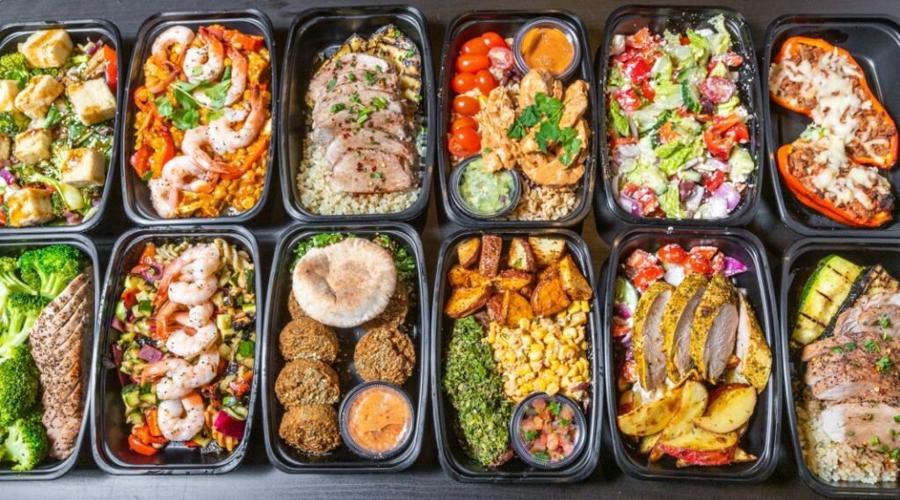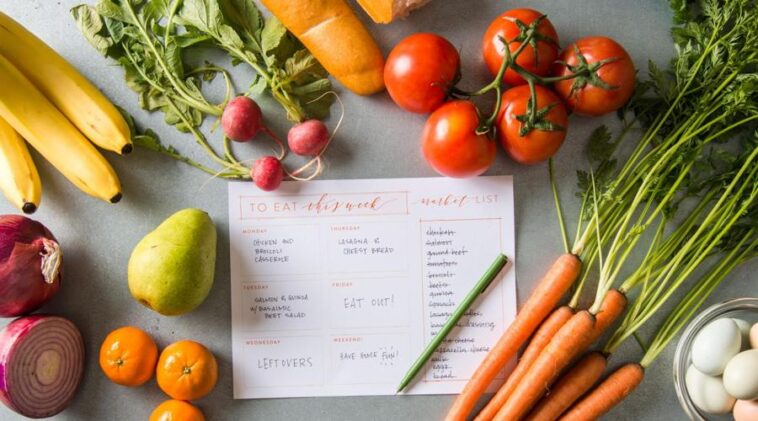Here’s a more detailed guide with more steps:
Set your goals: Determine your overall goal for meal planning. Is it to eat healthier, save time, save money, or all of the above? Having a clear goal in mind will help you stay focused and motivated.
Take inventory: Check your pantry, fridge, and freezer to see what ingredients you already have on hand. This will help you avoid buying unnecessary items at the grocery store.
Plan your meals: Use a meal planning template or app to plan your meals and snacks for the week. Take into account your nutritional needs, budget, and time constraints. Try to include a variety of foods from all food groups.
Make a grocery list: Based on your meal plan, create a grocery list of the items you need to buy. Stick to the list to avoid impulse purchases and overspending.
Shop smart: When you go grocery shopping, try to stick to the perimeter of the store where the fresh produce, meat, and dairy products are located. Avoid the aisles with processed and packaged foods as much as possible.
Prep ahead: Once you’re back home with your groceries, take some time to prep ahead. Wash and chop fruits and vegetables, cook grains and proteins, and portion out snacks. This will save you time and effort during the week.
Store food properly: Make sure to store your food properly to ensure it stays fresh throughout the week. Use airtight containers, label and date them, and store them in the fridge or freezer as appropriate.
Stay flexible: Remember that meal planning is not set in stone. Be open to making adjustments based on your schedule, mood, or preferences. If you planned to have chicken for dinner but feel like having fish instead, go for it!
What Is Meal Planning
Meal planning is the process of planning and organizing meals and snacks in advance. It involves deciding on the meals and snacks you will eat for a specific period of time, such as a week or a month, and making a list of the ingredients you need to purchase.
The goal of meal planning is to save time and money, eat healthier, and reduce food waste. It can also help individuals reach their nutrition and fitness goals by ensuring that they are consuming a balanced and varied diet. Meal planning can be done by anyone, regardless of cooking experience or dietary restrictions.
Why Is List At Least Four Steps To Successful Meal Planning Important
Here are four reasons why successful meal planning is important:
- Saves time: Planning your meals in advance can save you time during busy weekdays. You can do some of the prep work ahead of time, such as chopping vegetables, and have a plan for what you will eat, which means less time spent in the kitchen and less stress during meal times.
- Saves money: By planning your meals, you can make a grocery list and avoid buying unnecessary items or overspending. This can help you save money in the long run by reducing food waste and preventing impulse purchases.
- Promotes healthier eating: Meal planning allows you to choose healthy foods and create balanced meals that meet your nutritional needs. You can plan for a variety of foods from different food groups, making sure you get all the essential nutrients your body needs.
- Reduces stress: Meal planning can reduce stress around meal times by providing structure and eliminating the need to decide what to eat on the spot. Having a plan in place can also help you stick to your nutrition and fitness goals, which can further reduce stress and anxiety.

What Are The Four Steps To Successful Meal Planning
The four steps to successful meal planning are:
- Determine your nutritional needs: Before you start planning your meals, you need to understand your nutritional needs based on your age, sex, weight, height, activity level, and any health conditions you may have. You can use an online calculator or consult a registered dietitian for guidance.
- Choose a meal planning approach: There are several meal planning approaches to choose from, such as batch cooking, meal prepping, or simply creating a menu for the week. Choose an approach that suits your lifestyle, budget, and time constraints.
- Plan your meals and snacks: Once you have decided on your approach, plan out your meals and snacks for the week. Consider using a meal planning template to help you stay organized and on track. Make sure to include a variety of nutrient-dense foods from all food groups to ensure that you meet your nutritional needs.
- Shop and prep: After planning your meals, create a grocery list and head to the store. Buy the ingredients you need and consider prepping some of the meals in advance to save time during the week. For example, you can chop vegetables or cook some grains ahead of time. Finally, store your food properly to ensure it stays fresh throughout the week.
What Should Be Considered When Setting Goals And Priorities For Meal Planning
When setting goals and priorities for meal planning, consider the following factors:
Health needs: Consider any health conditions or dietary restrictions you have, such as allergies, intolerances, or chronic illnesses. Your meal plan should accommodate these needs and help you achieve optimal health.
Nutritional needs: Consider your nutritional needs, such as the number of calories, macronutrients (proteins, carbohydrates, and fats), and micronutrients (vitamins and minerals) you need to consume each day. Make sure your meal plan includes a variety of nutrient-dense foods to meet your needs.
Budget: Consider your budget when planning your meals. Choose foods that are affordable and plan meals that can be made in bulk or repurposed into leftovers to save money.
Time constraints: Consider how much time you have to prepare meals each day. Plan meals that can be prepared quickly or in advance, and consider using meal prep techniques to save time during the week.
Personal preferences: Consider your personal preferences, such as your favorite foods and cooking styles. Incorporate these preferences into your meal plan to make it enjoyable and sustainable.
By taking these factors into consideration when setting goals and priorities for meal planning, you can create a plan that is realistic, achievable, and tailored to your unique needs and lifestyle.
How Select Recipes For List At Least Four Steps To Successful Meal Planning
Here are four steps to select recipes for successful meal planning:
Consider your nutritional needs: Look for recipes that align with your nutritional needs and dietary goals. Choose recipes that are high in nutrients and low in unhealthy ingredients, such as saturated fats, added sugars, and sodium.
If you have specific dietary needs, such as gluten-free or vegetarian, make sure to choose recipes that meet those needs.
Assess your cooking skills: Choose recipes that match your cooking skills and experience. If you’re a beginner, look for simple and easy-to-follow recipes. If you’re an experienced cook, challenge yourself with more complex recipes.
Check the ingredients: Before choosing a recipe, check the ingredient list to make sure you have all the necessary ingredients or are able to easily obtain them. If you need to purchase ingredients, consider their cost and availability.
Consider your preferences: Choose recipes that you and your family will enjoy eating. Consider their taste preferences and any dislikes or allergies. Incorporate a variety of foods from different food groups to make sure you’re getting a balanced and nutritious diet.
By following these steps, you can select recipes that meet your nutritional needs, cooking skills, and personal preferences, which will make meal planning and preparation more enjoyable and successful.

How Create A Grocery List For Meal Planning
Here are some steps to create a grocery list for meal planning:
Review your meal plan: Review your meal plan and make a list of the ingredients you will need to prepare each meal. Consider the quantities needed and any substitutions you can make if necessary.
Check your pantry: Check your pantry, fridge, and freezer for any ingredients you already have. Cross off those items from your grocery list to avoid buying duplicates.
Categorize your list: Categorize your grocery list by food groups or sections of the store, such as produce, dairy, meats, and dry goods. This will help you navigate the store more efficiently and avoid forgetting items.
Consider quantities: Consider the quantities you need to buy based on your meal plan and the number of people you are cooking for. Avoid buying more than you need to reduce food waste.
Look for sales and deals: Check for sales and deals on items you need, and consider buying in bulk if it makes sense for your budget and needs.
Consider convenience: Consider convenience items such as pre-cut vegetables or pre-cooked grains if they fit within your budget and are helpful for saving time during meal prep.
By following these steps, you can create a grocery list that is organized, efficient, and tailored to your meal plan, budget, and needs.
How Prepare Meals Ahead Of Time For Meal Planning
Here are some steps to prepare meals ahead of time for meal planning:
Choose recipes that can be prepped in advance: Choose recipes that can be prepped in advance, such as casseroles, soups, stews, and salads. Look for recipes that can be made in large batches, as this will save you time and effort in the long run.
Schedule meal prep time: Schedule a specific time for meal prep, such as on a weekend or a weekday evening when you have some free time. This will help you stay organized and ensure that you have enough time to prepare all the meals.
Prep ingredients: Wash and chop vegetables, cook grains and proteins, and measure out spices and other ingredients in advance. Store each component separately in airtight containers in the fridge or freezer, as appropriate.
Assemble meals: Assemble meals by combining the prepped ingredients in the appropriate amounts. Use containers that are microwave or oven safe for easy reheating.
Label and store meals: Label each container with the name of the dish and the date it was made. Store the meals in the fridge or freezer, as appropriate. Make sure to use airtight containers to prevent freezer burn or spoilage.
Reheat and enjoy: Reheat the meals when you’re ready to eat, following the appropriate instructions for each dish. Enjoy the convenience of having healthy and delicious meals ready to go!
By following these steps, you can prepare meals ahead of time for meal planning and save time and effort during the busy week.
How Incorporate Variety Into Meal Planning
Here are some tips on how to incorporate variety into meal planning:
Plan for different cuisines: Plan meals that feature different cuisines, such as Italian, Mexican, Asian, or Middle Eastern. This will add variety in terms of flavors, spices, and cooking styles.
Include different protein sources: Incorporate different protein sources into your meals, such as chicken, fish, tofu, beans, and lentils. This will provide a variety of nutrients and help prevent taste fatigue.
Mix up your vegetables: Include a variety of vegetables in your meals, such as leafy greens, cruciferous vegetables, root vegetables, and nightshade vegetables. Try roasting, sautéing, or grilling vegetables for different textures and flavors.
Vary your grains: Switch up your grains by using different types of rice, quinoa, bulgur, farro, and pasta. This will provide a variety of nutrients and textures to your meals.
Experiment with new ingredients: Try incorporating new ingredients into your meals, such as different types of herbs, spices, sauces, or condiments. This will add excitement and new flavors to your meals.
Use seasonal produce: Incorporate seasonal produce into your meals to take advantage of their peak flavor and nutrition. This will also provide variety throughout the year.
By following these tips, you can add variety to your meal planning, making it more enjoyable and satisfying.

How Often Should List At Least Four Steps To Successful Meal Planning
The frequency of meal planning can vary depending on individual preferences and schedules. Here are some guidelines for how often to do meal planning:
Weekly meal planning:
Planning your meals weekly is a popular approach that works for many people. This allows you to plan out your meals for the upcoming week and create a grocery list accordingly. It also gives you the flexibility to adjust your plan based on any changes in your schedule or preferences.
Bi-weekly meal planning:
Bi-weekly meal planning involves planning your meals for two weeks at a time. This can save time and effort, as you only need to do meal planning every other week. However, it requires more advanced planning and can be less flexible than weekly meal planning.
Monthly meal planning:
Monthly meal planning involves planning your meals for an entire month. This requires more advanced planning and may be less flexible than weekly or bi-weekly planning. However, it can save time and effort in the long run and allows for a bigger picture approach to meal planning.
As needed meal planning:
As needed meal planning involves planning your meals only when necessary, such as when you have a busy week or special event coming up. This approach can work well for those who have unpredictable schedules or prefer a more flexible approach.
By incorporating these steps into your meal planning routine, you can find a frequency that works best for you and helps you achieve your goals for healthy and convenient meals.
How Save Money With Meal Planning
Meal planning can be a great way to save money on food expenses. Here are some tips for how to save money with meal planning:
Plan your meals around sales: Check store flyers and plan your meals around items that are on sale. This can save you money on ingredients and help you get the most for your money.
Buy in bulk: Consider buying non-perishable items in bulk, such as grains, nuts, and dried fruit. This can be more cost-effective than buying smaller quantities.
Use cheaper cuts of meat: Choose cheaper cuts of meat, such as chicken thighs or pork shoulder, which can be just as tasty as more expensive cuts. You can also try using vegetarian protein sources such as beans, lentils or tofu which are usually cheaper.
Use leftovers: Plan meals that can be repurposed into leftovers, such as soups, stews, and casseroles. This can save you money by reducing food waste and providing easy, ready-made meals for later.
Make your own meals and snacks: Make your own meals and snacks instead of relying on pre-packaged or fast food. This can save you money and is usually healthier.
Use seasonal produce: Buy produce that is in season, as it is usually cheaper and fresher than out-of-season produce that has been imported.
By incorporating these tips into your meal planning routine, you can save money on your food expenses while still eating healthy and delicious meals.
How Save Time With Meal Planning
Meal planning can be a great way to save time in the kitchen. Here are some tips for how to save time with meal planning:
Choose simple recipes:
Choose recipes that are simple and easy to prepare, with minimal ingredients and steps. This will save you time and effort in the kitchen.
Use meal prep techniques:
Use meal prep techniques such as batch cooking, making freezer meals, or prepping ingredients in advance. This will save you time during the week and make meal preparation more efficient.
Plan for leftovers:
Plan meals that can be repurposed into leftovers, such as soups, stews, and casseroles. This will save you time by providing easy, ready-made meals for later.
Create a grocery list:
Create a grocery list based on your meal plan to avoid unnecessary trips to the store and save time.
Utilize kitchen appliances:
Use kitchen appliances such as slow cookers, pressure cookers, and rice cookers, to save time and effort during meal preparation.
Cook once, eat twice:
Plan meals that can be used for multiple meals or repurposed into new dishes, such as roasted vegetables that can be used for salads or in wraps.
By incorporating these tips into your meal planning routine, you can save time in the kitchen and make meal preparation more efficient.

Conclusion
In conclusion, successful meal planning involves the following four steps: Determine your nutritional needs based on your age, sex, weight, height, activity level, and any health conditions you may have. Choose a meal planning approach that suits your lifestyle, budget, and time constraints.
Plan your meals and snacks in advance, considering a variety of nutrient-dense foods from all food groups. Create a grocery list based on your meal plan, categorizing it by food groups or store sections, considering quantities needed, and looking for sales and deals.
By following these steps, you can save time and money, eat healthier, and reduce food waste, while ensuring that you meet your nutritional and fitness goals. Successful meal planning can help you achieve a balanced and varied diet, make meal preparation more efficient, and reduce stress around meal times.
How can you make meal planning a family activity?
To make meal planning a family activity, involve family members in selecting recipes and creating the grocery list. Also, consider having each family member contribute to the meal preparation.
How can you make meal planning more enjoyable?
To make meal planning more enjoyable, try new recipes and experiment with different ingredients and flavors. Also, consider planning meals around a theme or cuisine to add variety.
How can you track your progress with meal planning?
You can track your progress with meal planning by keeping a log of the recipes you have tried, noting any changes you made, and recording feedback from family members.
How can you adjust meal planning for dietary restrictions?
To adjust meal planning for dietary restrictions, consider selecting recipes that meet specific dietary needs and substituting ingredients as necessary. Also, consult with a nutritionist or healthcare provider for guidance.
How can you stay motivated with meal planning?
To stay motivated with meal planning, set achievable goals, reward yourself for progress, and track your progress over time. Also, involve family members or friends in the meal planning process for added support.




